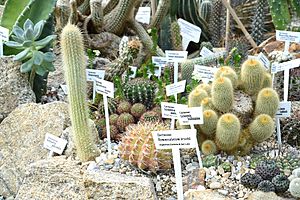Grusonia bulbispina facts for kids
Quick facts for kids Grusonia bulbispina |
|
|---|---|
 |
|
| Scientific classification | |
| Genus: |
Grusonia
|
| Species: |
bulbispina
|
Grusonia bulbispina is a unique type of cactus. It is part of the Cactaceae family, which includes all cacti. This interesting plant is native to Mexico, where it thrives in dry, desert-like conditions. It's known for its special spines, which give it its name.
Contents
What is Grusonia bulbispina?
Grusonia bulbispina is a small, shrub-like cactus. It often grows in clumps, forming a low bush. Its stems are usually green and segmented, meaning they are made of several connected parts. These segments can easily break off, which helps the plant spread.
Spines and Glochids
One of the most noticeable features of this cactus is its spines. The name "bulbispina" means "bulbous spine." This refers to the unique, swollen base of its spines. These spines are very sharp and help protect the plant from animals. Like many cacti, it also has tiny, barbed bristles called glochids. These can be very irritating if they get into your skin.
Flowers and Fruit
During its blooming season, Grusonia bulbispina produces beautiful flowers. These flowers are usually yellow or greenish-yellow. They attract pollinators like bees and other insects. After the flowers are pollinated, they develop into small, fleshy fruits. These fruits often have a reddish or purplish color.
Where Does It Grow?
This cactus is found naturally in specific regions of Mexico. It prefers dry, rocky soils in deserts and semi-desert areas. These environments are often very hot during the day and cool at night. The plant is well-adapted to these harsh conditions.
Its Natural Habitat
In its native habitat, Grusonia bulbispina grows alongside other desert plants. It can be found on plains, hillsides, and even in rocky canyons. It needs plenty of sunlight to grow well. The plant is very tough and can survive long periods without rain.
Amazing Desert Adaptations
Cacti like Grusonia bulbispina have amazing ways to survive in dry places. They have special features that help them store water and protect themselves. These adaptations allow them to live where other plants cannot.
Storing Water
The thick, fleshy stems of this cactus are designed to store water. When it rains, the plant quickly absorbs water and holds it inside its stems. This stored water helps the cactus survive during long dry spells. Its waxy skin also helps prevent water from evaporating.
Protection from Animals
The sharp spines and tiny glochids are a great defense. They deter animals from eating the cactus. This protection is very important in the desert, where food and water can be scarce. The spines also help shade the plant's surface, reducing water loss.
How Does It Reproduce?
Grusonia bulbispina can reproduce in a couple of ways. It can produce seeds, just like many other plants. It can also reproduce from its stem segments. This makes it very good at spreading in its environment.
Reproduction by Seeds
The flowers of Grusonia bulbispina are pollinated, leading to the formation of seeds. These seeds are found inside the fruit. When the fruit ripens and falls, the seeds can sprout new plants if conditions are right. This is a common way for plants to reproduce.
Reproduction by Stem Segments
One unique way this cactus reproduces is through its stem segments. If a segment breaks off, it can root in the soil and grow into a new plant. This is called vegetative reproduction. It's a very effective way for the cactus to spread and colonize new areas.
See also
 In Spanish: Choya perritos para niños
In Spanish: Choya perritos para niños

